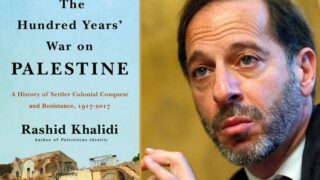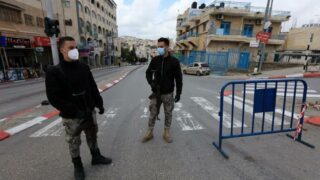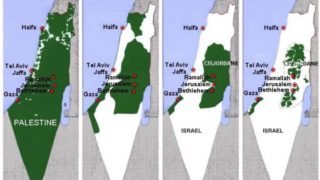Israeli soldiers have shot to death dozens of young Palestinians in the occupied cities of the West Bank and Jerusalem in recent months, many of them after they tried to attack soldiers or settlers with knives. After they are killed, the punishment continues for their families; the bodies are kept in Israeli freezers for ambiguous and unexplained months, until they are abruptly delivered: frozen, blackened blocks of ice, after midnight, often to graveyards far from home
Translated by International Boulvard
More than 200 Palestinians have been martyred since Oct 1 of last year, a quarter of them children not even in their teens. Killed with Israeli bullets. And in the aftermath of their deaths, their families are punished in the most horrible ways by the procedures the Israeli state imposes upon them. Among other post-mortem punishment methods employed by the Israelis: withdrawal of family unification permits, with families expelled to the West Bank; threatened deportation of families to the Gaza Strip; arrests of families of the dead, demolishing the houses of relatives; pouring concrete into houses of families to render them inaccessible and permanently unusable. All these ruthless and revolting measures have been used, but now they have found a new way of striking deep at the heart of Palestinians’ human sensitivities: Israel is confiscating the bodies of the dead, preventing their families from bidding them farewell and burying them with dignity and respect.
Palestinian families routinely wake up in the morning to videos of the execution of their sons, documenting their last instants of life, their final shouts and last breaths. Others whose sons were killed in some dark corner stay themselves in the dark for long periods, knowing nothing about what actually happened to sons who got up in the morning, left for school and never returned. They have not the slightest information, except for the knowledge that the bodies of their son or daughter is sleeping there, in the Israeli death freezers, body turned into a mass of ice maintained at 25 degrees below zero.
Israel’s response to the popular upheaval shaking Palestine is deliberate and systematic, issued in the form of a government decree, and backed by broad support among Zionists: the refusal to return the bodies of their dead to Palestinian families. Some families have been waiting for two weeks, others three months, others still six months or more. Seizing the corpses of the dead and prohibiting their funerals, the Israelis believe, is a good deterrent: it may prevent new stabbing attacks, and it dispenses with the burial ritual, the procession which turns the dead into models other Palestinians seek to emulate.
And when Israel ultimately does decide to return the corpses, it draws out the process in a way that only adds more distress to the ordeal of the relatives; the bodies of the martyrs are used as if they are trump cards in a hand of poker. The families are obliged to sign an agreement inventorying a series of drastic conditions they must meet to receive the body of their dead relative. Frequently they must pay large sums of money in exchange for the corpse. The Israeli security services do not inform the families of the actual date and time they will hand over the body, instead, following the wording of the signed agreement, saying that they will receive the body “in the coming days.” In the case of Moataz Awissat, sixteen when he was killed, the body has been held by the Israelis for six months; the family signed the agreement and has awaited the “coming day” for two months now.
The occupying army also imposes the condition, in these written agreements, that the body will only be handed over late in the night, generally after midnight. The location is likewise set by the Israelis, typically at the entrance of the graveyard. No more than four family members may be present at the moment the body is handed over, and no more than 20 or 30 people are allowed to attend the burial. Those who attend the burial must arrive individually to the graveyard, and they must leave one followed by the other; no marches or processions are allowed. The entire ritual of the burial has to be carried out in less than an hour and a half. In most cases the Israeli army of occupation confiscates all cellphones from people attending the burial, to prevent them from taking pictures or filming the event. Among other stated conditions, the Palestinians must refrain from chanting what the Israelis refer to as “hostile slogans.” Finally, in numerous cases, Israel imposes on families of martyrs from the West Bank the condition that they bury their dead in Jerusalem so that the burial can be more tightly monitored by the Israeli security agencies.
Israel justifies holding on to the corpses-and the brutal conditions it imposes for eventually handing them over-as measures to prevent relatives from perpetuating positive memories of their dead, and preventing ‘incitement’ via large public funerals which are also themselves opportunities for further confrontations that worsen the ongoing situation.
But the crazed sadism of the Israeli state has its methods.
Beneath the surface is Israel’s never-ending concern with protecting its own military personnel from possible indictments by international courts, or even by the country’s domestic criminal justice system.
Because even though the Israeli judiciary – both civil and military – is a cog in the vast machine of Zionist oppression, it sometimes finds itself in rare instances obliged to answer petitions or lawsuits against its own soldiers. Such cases only happen when there is inescapable hard evidence at hand. This for example was the case with the Hebron [West Bank] martyr Abdelfattah al-Sharif, who we see in a video clearly alive, still breathing and bleeding, but incapable of moving or running away, and then clearly see a soldier shooting him in the head in cold blood. In spite of the fact that the entire scene was caught on video [and posted on the Internet], the Israelis nevertheless went on a rampage through the entire neighborhood where al-Sharif was executed – seizing all the surveillance footage from stores and building entrances, and detaining or harassing and intimidating all the Palestinian eyewitnesses to the crime.
The post-mortem strategies employed [with the corpses of our martyrs]– reflect more than the typical Israeli vindictive mania or its brutal, though impotent floundering. The confiscation of the dead bodies and the conditions imposed for their return, and particularly the requirement that they be buried immediately after the release of the body, suggest that they do not want the bodies to undergo autopsies.
An autopsy of course is central to adjudicating cases of murder. It can for example prove beyond doubt that the martyr was killed in cold blood, since it provides exact information on the cause of death. For example a forensic pathologist can determine if death occurred as a consequence of a long period of bleeding rather than the instantaneous work of a killer bullet; revealing thus the cases in which Israeli medical teams deliberately withhold care from a person who has been shot, preventing the saving of his life. Likewise an autopsy can show which particular bullet from a series of wounds actually caused the death of a person, or catalog how many shots a body was pierced by.
Without an autopsy where would have been the scientific proof – other than the sounds of the shots and the testimony of witnesses and journalists – that the Israelis fired 50 bullets into young Mohammad Abu Khalaf at Bab al-Amoud in Jerusalem?
An autopsy analyzes which parts of a body were shot, whether the bullets were aimed at the upper or the lower extremities, and can show whether the person was shot in the back, thus indicating legally that the victim was killed while not posing a possible danger to the shooter. Autopsies examine the angle from which a bullet enters and exits the body, indicating the body’s position at the time, and it can show burned spots on the clothes of the martyr, indicating the distance from which a bullet was fired. All these pieces of evidence are deliberately concealed by the Israelis via their policy of extortion with the corpses of the martyrs.
And we have not arrived at the furthest depths of human indignity and ugliness; not yet.
On March 21, the family of the child martyr Hassan Menassra got a telephone call saying they should get ready to receive the corpse of their son in the next few hours. Hassan was only fifteen years old when he had been shot six months before. That same day, his cousin Ahmed Menassra, 13, had also been shot with live ammunition by the occupying army. The soldiers left him bleeding on the ground for a long period; a witness filmed the scene from up close, as Israeli doctors and paramedics stand around him without giving him any medical treatment. Israeli settlers meanwhile surround him to insult him and spit on his bleeding body. More recently a video was released of Ahmed later in an interrogation room with Israeli security agents practicing horrific mental torture on the 13-year old.
After midnight on the day Hassan’s family finally received the call regarding their son’s body, Palestinian news outlets reported that his family refused to take the body of their son, giving it back to the Israelis. Hassan’s father explained: “This is an attempt to humiliate us even further. The condition they gave him to us in, they know full well that we will not be able to wrap him in a shroud, we will not be able to kiss him, we will not be able to say goodbye, we will not be able to bury him.”
Hassan’s father Khaled was referring to the state in which Israel delivers the bodies of the martyrs to their families: they don’t take them out of the freezers for enough time to allow the bodies to recover a normal temperature which would allow the family to wash and say farewell to their dead in a decent manner. The families are obliged to bury the dead in less than one hour and a half, they receive the body as a mass of ice, they can’t even identify their dead; in some cases the families don’t recognize the body because the whole corpse is completely blackened, which indicates that it was neglected and left to wait for a long time before it was put in the morgue. The father receives his son as a literal mass of ice, he hugs a mass of ice and kisses a mass of ice and he is incapable of saying goodbye or giving him the proper burial. Even the ritual of burial becomes risky; families worry that the block of ice that is their son will break into pieces during the process.
In the oldest piece of human literature, the Sumerian hero Gilgamesh refuses to leave side of the body of his friend Enkidu for seven days and nights. Only on the seventh day, when he sees a worm coming out of the nose of the corpse does he finally bury him with his own hands. When he first appears in the story, Enkidu is a savage, a man who had been raised by wild animals, but Gilgamesh has succeeded in making him into a human before his death. In another ancient work of literature, Antigone refuses to abandon the dead body of her brother to the wild animals who would devour him, insisting on burying him.
That you deprive a human being of the tomb that his culture has created to confront death, means that you erase him from the most ancient and deeply anchored of human rituals, that you erase from him his humanity. But Antigone fought the king for the right to bury her brother, and though she too was killed in the end, she broke the will of the king and brought him back to the path of reason and justice. As for Gilgamesh, the legend says that after he buried his friend Enkidu, confirming the value of his humanity, he walked away in search of eternal life. And we, too, we want our martyrs honored so that we can bring back reason and justice, and continue walking forward in our quest for life.







